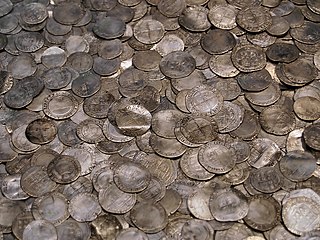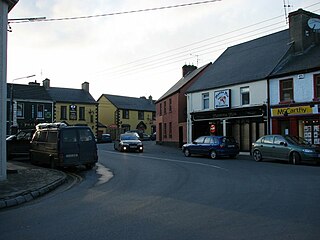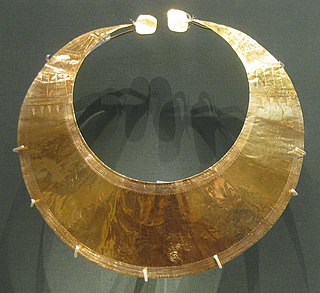
A torc, also spelled torq or torque, is a large rigid or stiff gentlemen's neck ring in metal, made either as a single piece or from strands twisted together. The great majority are open at the front, although some have hook and ring closures and a few have mortice and tenon locking catches to close them. Many seem designed for near-permanent wear and would have been difficult to remove. Torcs have been found in Scythian, Illyrian, Thracian, Celtic, and other cultures of the European Iron Age from around the 8th century BC to the 3rd century AD. For Iron Age Celts, the gold torc seems to have been a key object. It identified the wearer as a person of high rank, and many of the finest works of ancient Celtic art are torcs. Celtic torcs disappeared in the Migration Period, but during the Viking Age torc-style metal necklaces, mainly in silver, came back into fashion. Similar neck-rings are also part of the jewellery styles of various other cultures and periods.

A hoard or "wealth deposit" is an archaeological term for a collection of valuable objects or artifacts, sometimes purposely buried in the ground, in which case it is sometimes also known as a cache. This would usually be with the intention of later recovery by the hoarder; hoarders sometimes died or were unable to return for other reasons before retrieving the hoard, and these surviving hoards might then be uncovered much later by metal detector hobbyists, members of the public, and archaeologists.

Newmarket-on-Fergus, historically known as Corracatlin, is a town in County Clare, Ireland. It is 13 kilometres from Ennis, 8 kilometres from Shannon Airport, and 24 kilometres from Limerick.

The Hoxne Hoard is the largest hoard of late Roman silver and gold discovered in Britain, and the largest collection of gold and silver coins of the fourth and fifth centuries found anywhere within the former Roman Empire. It was found by Eric Lawes, a metal detectorist in the village of Hoxne in Suffolk, England in 1992. The hoard consists of 14,865 Roman gold, silver, and bronze coins and approximately 200 items of silver tableware and gold jewellery. The objects are now in the British Museum in London, where the most important pieces and a selection of the rest are on permanent display. In 1993, the Treasure Valuation Committee valued the hoard at £1.75 million.

The prehistory of Ireland has been pieced together from archaeological evidence, which has grown at an increasing rate over the last decades. It begins with the first evidence of permanent human residence in Ireland around 10,500 BC and finishes with the start of the historical record around 400 AD. Both the beginning and end dates of the period are later than for much of Europe and all of the Near East. The prehistoric period covers the Palaeolithic, Mesolithic, Neolithic, Bronze Age and Iron Age societies of Ireland. For much of Europe, the historical record begins when the Romans invaded; as Ireland was not invaded by the Romans its historical record starts later, with the coming of Christianity.

The Oxus treasure is a collection of about 180 surviving pieces of metalwork in gold and silver, most relatively small, and around 200 coins, from the Achaemenid Persian period which were found by the Oxus river about 1877–1880. The exact place and date of the find remain unclear, but is often proposed as being near Kobadiyan. It is likely that many other pieces from the hoard were melted down for bullion; early reports suggest there were originally some 1500 coins, and mention types of metalwork that are not among the surviving pieces. The metalwork is believed to date from the sixth to fourth centuries BC, but the coins show a greater range, with some of those believed to belong to the treasure coming from around 200 BC. The most likely origin for the treasure is that it belonged to a temple, where votive offerings were deposited over a long period. How it came to be deposited is unknown.

The Broighter Gold or more correctly, the Broighter Hoard, is a hoard of gold artefacts from the Iron Age of the 1st century BC that were found in 1896 by Tom Nicholl and James Morrow on farmland near Limavady, in the north of Ireland. The hoard includes a 7-inch-long (18 cm) gold boat, a gold torc and bowl and some other jewellery.

The Thetford Hoard is a hoard of Romano-British metalwork found by Arthur and Greta Brooks at Gallows Hill, near Thetford in Norfolk, England, in November 1979, and now in the British Museum. Dating from the mid- to late-4th century AD, this hoard is a collection of thirty-three silver spoons and three silver strainers, twenty-two gold finger rings, four gold bracelets, four necklace pendants, five gold chain necklaces and two pairs of necklace-clasps, a gold amulet designed as a pendant, an unmounted engraved gem, four beads, and a gold belt-buckle decorated with a dancing satyr. A small cylindrical lidded box made from shale also belonged to the hoard.

The National Museum of Ireland – Archaeology is a branch of the National Museum of Ireland located on Kildare Street in Dublin, Ireland, that specialises in Irish and other antiquities dating from the Stone Age to the Late Middle Ages.

Mooghaun is a late Bronze Age hill fort located in County Clare, Ireland. It is a well preserved, recently excavated site, occupying an entire hill with wide views of the surrounding lands. Believed to be the largest hill fort in Ireland, it is one of the region's main tourist attractions.

Gold working in the Bronze Age British Isles refers to the use of gold to produce ornaments and other prestige items in the British Isles during the Bronze Age, between circa 2500 and c.800 BCE in Britain, and up to about 550 BCE in Ireland. In this period, communities in Britain and Ireland first learned how to work metal, leading to the widespread creation of not only gold but also copper and bronze items as well. Gold artefacts in particular were prestige items used to designate the high status of those individuals who wore, or were buried with them.
Tomfinlough is a civil parish in County Clare, Ireland. A Christian establishment was first made here around 540 AD. The parish lands were often raided by Irish, Viking, Norman and English forces in the years that followed. The church was allowed to fall into ruins during the period when the Catholic Church was penalized in Ireland.

The Boscoreale Treasure is the name for a large collection of exquisite silver and gold Roman objects discovered in the ruins of the ancient Villa della Pisanella at Boscoreale, near Pompeii, southern Italy. Consisting of over a hundred pieces of silverware, as well as gold coins and jewellery, it is now mostly kept at the Louvre Museum in Paris, although parts of the treasure can also be found at the British Museum.

The Tell el-Ajjul gold hoards are a collection of three hoards of Bronze Age gold jewellery found at the Canaanite site of Tell el-Ajjul in Gaza. Excavated by the British archaeologist Flinders Petrie in the 1930s, the collection is now mostly preserved at the British Museum in London and the Rockefeller Museum in Jerusalem. The treasure ranks amongst the greatest Bronze Age finds in the Levant.

The Dowris Hoard is the name of an important Bronze Age hoard of over 200 objects found in Dowris, County Offaly, Ireland. Items from the deposit are currently split between two institutions: the National Museum of Ireland in Dublin and the British Museum in London.

The Coggalbeg hoard is an Early Bronze Age hoard of three pieces of Irish gold jewellery dating to 2300–2000 BC. It is now in the National Museum of Ireland – Archaeology in Dublin, where it is normally on display.

Scottish jewellery is jewellery created in Scotland or in a style associated with Scotland, which today often takes the form of the Celtic style. It is often characterised by being inspired by nature, Scandinavian mythology, and Celtic knot patterns. Jewellery has a history in Scotland dating back to at least the Iron Age.
The Heights of Brae hoard is a group of at least eleven Bronze Age gold ornaments, currently held in the National Museum of Scotland. Gold bracelets, 'cup-ended ornaments' and a corrugated gold band were discovered through ploughing, and later excavation, in a field in the Highland region in Scotland. The objects date to the Late Bronze Age in Britain, around 950-750 BC, and represent the largest hoard of Bronze Age gold objects from Scotland.
















